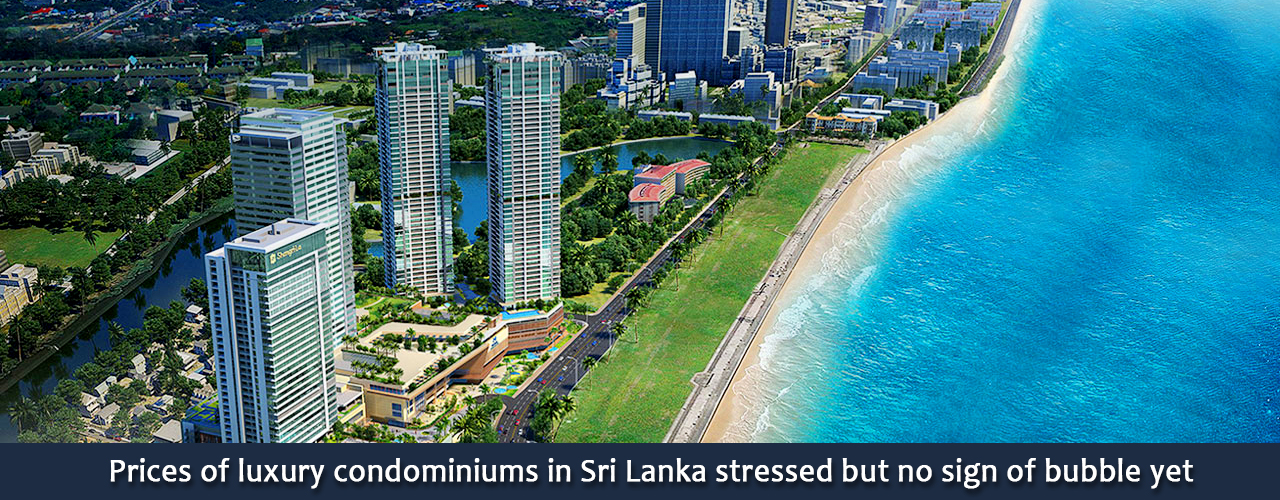Prices of luxury condominiums in Sri Lanka stressed but no sign of bubble yet
CEO of Candor Group, Ravi Abeysuriya states that high levels of unabsorbed supply could result in the stagnation or reduction of the country’s high-end residential condominium in 2018 to 2020.
“Some developers may use more aggressive competitive tactics due to threat on profitability,” he said.
“Significant demand from untapped sources such as foreign high net worth individuals are needed as the supply glut is mostly present in the luxury segment,” he added.
Approximately 5,000 units of luxury condominiums may be introduced to the market by 2020 with around 2,800 becoming available by 2018, but this level of supply may exceed present demand.
“However, large price corrections are not expected due to the low level of leverage in the system and large pool of constrained investors,” Abeysuriya predicted.
“The state has a role to play by improving investor confidence. Capital gains tax may dampen demand from investment driven investor class,” he stated.
According to Roshan Madawela, CEO of the Research Intelligence Unit (RIU)that handles market studies in the real estate sector, the most demanding area of the market will persist in the top-end.
“We believe that strong GDP growth supported by incentives that make it attractive for non-resident buyers to purchase apartments in Sri Lanka will continue to position Sri Lanka as an internationally attractive proposition where property and apartments are concerned,” he said
“It is unfortunate that this market segment is not being better supported by policy makers as it has the potential to make a significant contribution to the country’s FDI and also serves to attract talented individuals and entrepreneurs back to Sri Lanka,” Madawela stated.
A research conducted by Madawela’s RIU indicates that aside from the top-end, the “affordable luxury”group which has been constructed for the purpose of those seeking to establish a residence, is properly sustained by demographic and life-style trends, as such prudentlyvalued developments situated in convenient locations offering quality features and fittings have the possibility of maintaining good will continue to experience positive growth.
Investopedia defines a housing bubble as “… a run-up in housing prices fuelled by demand, speculation and exuberance….”¹
Investopedia goes on to state, “Housing bubbles usually start with an increase in demand, in the face of limited supply which takes a relatively long period of time to replenish and increase. Speculators enter the market, further driving demand. At some point, demand decreases or stagnates at the same time supply increases, resulting in a sharp drop in prices — and the bubble bursts.”²
According to Abeysuriya it is hard to exactlyforecast the bursting of an asset bubble. However indications like a steep rise in property prices making them unsustainable is an initial red-light.
“This is the easiest sign to see, however, I must say, Sri Lanka condominium sector is new product which came into prominence only four years ago,” he said.
“As long as people are buying for their use with their-own money then there is no issue – it is only when the borrowed money comes that a bubble happens because then they have short time to sell and they have to sell cheap,” he stated.
He said that such an occurrence could take place in any market or class of asset, adding that up to date fifteen such real estate bubbles had occurred affecting countries like India and Malaysia as well.
Other signs include: Real rental yields – annual rental income net of expenses as percentage of apartment prices, real household income -affordability measures – ratio of median house prices to median disposable incomes, expressed as a percentage.³
“We saw a rapid increase in margin lending before the 2010 stock market bubble – lending to property sector has been accelerating during last three and half ½ years,” Abeysuriya said.
“From Jan 2014 to June 2017, year- on – year growth of commercial banks’ loans and advances to construction sector has grown by around 20 percent,” he added.
As much as 53% of total new loans or LKR 567 billion has been loaned out to the property sector after January 01, 2014, LKR 215 billion or 38% for housing LKR 352 billion or 62% for property developers.³
He also said that levels of household debt and non-performing loans (NPLs) of the property industry were another cause for concern.
“The NPLs would normally go up during a crisis or when a crisis is nearing. As of now, based on the NPL numbers, we do not see an increase in the NPLs to the property sector,” Abeysuriya explained.
However, one major default could scare away investors – for example in 2013 there were some concerns of an Indian housing bubble, when in August 2013, Orbit Corporation, a Mumbai-based real estate firm, defaulted USD 150 million taken from LIC Housing Finance.
“In September 2013, it was reported that about 650 million sq. feet of assets or about 600,000 housing units remained unsold, according to the research firm LiasesForas,” he said.
“Some builders were seen dropping prices and offering other incentives to buyers. In the case of the United States the property bubble was mainly due to the low interest rates for a long period of time but in Sri Lanka this is not the case we have higher rates – so it will not happen,” he said.
OSL TAKE:
The assurance that there is no bubble in the luxury condominium sector would definitely provide an impetus to the construction industry, which recorded a huge growth due to the large number of apartment projects.
-
¹ http://www.investopedia.com/terms/h/housing_bubble.asp
²http://www.investopedia.com/terms/h/housing_bubble.asp
³http://www.lankabusinessonline.com/sri-lankas-high-end-condos-under-pressure-no-bubble-yet/
| Article Code : | VBS/AT/08092017/Z_6 |

